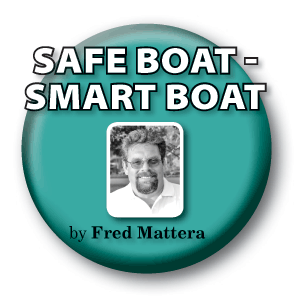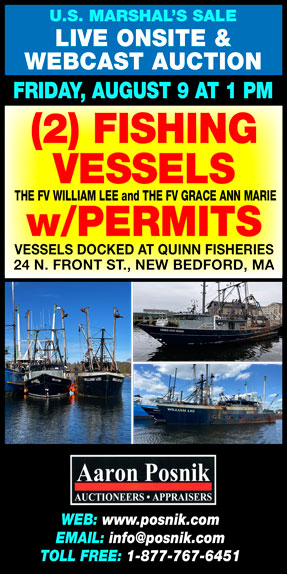Crew safety orientation vital for all fishing vessel operators
Obviously, all vessels should be equipped with features to ensure the safety of the crew. But crewmen should also be aware of these features and knowledgeable about their use. And that can’t be assumed; it must be taught and practiced.

A qualified Coast Guard-approved marine drill instructor, Fred Mattera of Point Judith, RI is the owner/president of North East Safety Training Co. (NESTCo), which conducts fishing vessel drills and inspections and basic safety training workshops.
All fish vessel captains and crew members should be familiar with the requirements of the Fishing Vessel Safety Regulations.
Fishing Vessel Safety Regulations booklets are available through your areas USCG Dockside Examiner’s office.
Communications
Clear communications between the pilothouse and the deck should be maintained by means of a properly located functioning hailer and speakers.
It is important during fishing operations – such as hauling and setting gear – that loud hailers function between the deck and pilothouse, over and above the fray of noise from the main engine, genset, and engaged PTO.
The captain may sense a problem at any time and need a crewman in the engineroom to respond immediately. Or, there is always the possibility of a man overboard situation (MOB) where the crew needs to alert the captain immediately.
For smaller vessels, with crew and captain working together in close proximity, voice and/or hand signals are appropriate.
Always remember: when hoisting or moving heavy equipment, the crewman at the hoisting point must use hand signals. There must be a clear view between the crewman at hoist point and the crewman at the cargo winch valve – each using a fist with thumb up or down (for up or down movement) and thumb right or left (for the same), and a closed fist to stop.
In all such cases, clear, effective communications are a must.
Bulwarks, railings
All exposed working decks should be surrounded by bulwarks, rails, chains, or wire rope that adequately protect the crew.
The recommended bulwarks height is 39.5”, with the lowest point 9” above the deck.
For heavy sea conditions, the vessel should have appropriately placed bulwark rails or handrails; storm rails on the outside of the superstructure and pilothouse; and guard rails, gangways, lifelines, or underdeck passage between quarters, machinery spaces, and other living and working areas.
Periodically inspect handrails, hand holds, and lifelines to be sure they are secure. I believe you can never have too many hand holds.
Stern trawlers should have a means of protection fitted across the stern ramp when handling the net is not underway – by means of a hinged door, chain, or lifeline snapped across the ramp.
Covers, openings
Exposed weather deck hatches should have locking closures. All closures should be capable of being opened from either side, with all gaskets secure and maintained in good condition to maintain watertight integrity.
Hatches, deck plates, and other openings should only be open when required by specific operations and they should be reclosed and secured as soon as the job is done. When they are open, all hinged covers should be latched to guard against accidental closing.
Wherever practicable, ropes or railings should be provided around any uncovered deck opening – including the fish hold flush hatch – when unloading fish.
Escape openings should have hand holds above them to help crewmen exit in an emergency.
Noise, fumes
Keep passageway doors closed to keep fumes, odors, and noise from entering working and living quarters.
Preferred maximum onboard noise levels should not exceed 75 decibels.
Ways to reduce noise levels and protect your crew from toxic fumes include:
- Mount vibrating machinery, especially gensets, on resilient motor mounts;
- Fit noise barriers or sound absorbing material (fire resistant) around the engineroom and other noisy spaces;
- Mount exhaust, vents, and other service lines with flexible fittings where possible;
- Install and/or inspect seals around doors and openings that separate compartments;
- Install sound absorption material in living quarters;
- Isolate noisy compartments from manned compartments;
- Install seals and/or sound insolation in the chase way from the engineroom to pilothouse where wires and piping penetrate; and
- Install smoke and carbon monoxide detectors throughout the vessel interior.
Deck coating
Apply deck tiles, non-skid paint, or grating on walking and working decks, around hatches, doors, and passageways, around deck and winches, and around the life raft.
It is difficult to launch a life raft from a slippery coachtop on vessels at severe angles of heel.
Stairways, ladders
Stairways and ladders must be adequately constructed and secured to permit safe passage both in port and at sea.
Treads should be flat and covered with non-skid, or made of non-slip material.
Stairways and ladders in high traffic areas should be permanently attached. Emergency escape ladders may be portable if they are stowed adjacent to the exit and capable of being secured in place by hand.
Install fixed ladders at least 6” from the bulkhead to permit a secure foothold.
Where ladders are constructed with stringers, the rungs should pass through the stringers, rather than being secured on the outside.
Avoid using portable ladders at sea.
If you must use them, mount them on a firm flat base and lash them securely in place.
Repair any ladder missing a rung or step as soon as possible.
Install hand holds wherever they are needed and it is always important to keep the area at the base of any ladder free of obstacles.
Means of escape
Normally manned spaces – such as accommodations, galleys, machinery spaces, and working areas – must have two means of escape as remote from each other as possible, to minimize the possibility that both exits could be blocked at the same time in an emergency.
You should be able to open all escape hatches from the inside; they should not be fitted with locks or closures that prevent quick openings.
Many vessels use deck plates; if so, it is best to tie a 2-pound hammer at the base of the deck plate to knock the release mechanism in a counterclockwise motion, opening the deck plate.
Lubricate and check the deck plate mechanism regularly.
This means of escape should never be obstructed with gear and crews should practice exiting in order to be prepare for an emergency.
In conclusion
An orientation of all shipboard safety equipment should be required of all new crewmen, and then procedures should be practiced and observed by the full crew periodically.
It is imperative that any crewman who observes or recognizes a deficiency in the equipment, procedures, and/or operations discussed here report it to the captain promptly for direct action.

To get the rest of this story and much more you’ll need the October 2016 issue of Commercial Fisheries News – please choose from the following options:
BUY a Single PRINT edition of CFN that is delivered by MAIL. PRINT EDITION
Quickly enjoy ONLINE access with our Hi-DEF flip-book. PURCHASE ONLINE EDITION
(Read online flip-book immediately with purchased access key and download a copy for yourself to keep. Not sure if it works for you? Try a FREE SAMPLE HERE.)
SAVE BIG when you SUBSCRIBE!







